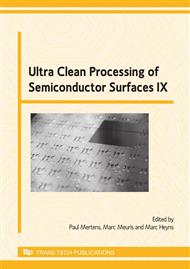p.245
p.249
p.253
p.257
p.261
p.265
p.269
p.273
p.277
Chemical and Mechanical Analysis of HDIS Residues Using Auger Electron Spectroscopy and Nanoindentation
Abstract:
Photoresist stripping after ion implantation at high dosages (>1E15 atoms/cm2) is the most challenging dry strip process for advanced logic devices. Such high-dose implant stripping (HDIS) frequently leaves residues on the wafers after dry strip, unless fluorine chemistries are employed in the stripping plasma. Silicon loss requirements at sub-45nm nodes generally preclude such aggressive stripping chemistries. Instead, a wet clean is used to remove residues. However, the nature of the residues is not well understood, and are believed to usually contain some of the cross-linked, carbonized organic polymer formed in the implant [1]. In this paper we present chemical and mechanical data on HDIS residues produced from oxidizing and reducing chemistry strip processes.
Info:
Periodical:
Pages:
261-264
Citation:
Online since:
January 2009
Keywords:
Price:
Сopyright:
© 2009 Trans Tech Publications Ltd. All Rights Reserved
Share:
Citation:


